
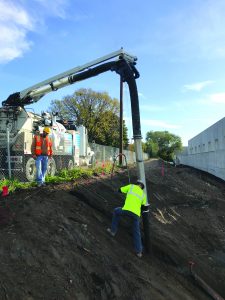 Since 1995, Ontario Excavac has offered vacuum excavating services, primarily for municipalities and hydro companies. Much of the Vaughan, Ont.-based company’s work involves “potholing”— that is, locating underground utilities then removing enough soil in non-destructive fashion to expose pipes and cables.
Since 1995, Ontario Excavac has offered vacuum excavating services, primarily for municipalities and hydro companies. Much of the Vaughan, Ont.-based company’s work involves “potholing”— that is, locating underground utilities then removing enough soil in non-destructive fashion to expose pipes and cables.
“The main advantage [of vacuum excavation] is that you don’t damage the utility when you see it, because you’re just washing the dirt away then sucking it up, rather than going in completely blind with a backhoe not knowing what you’re digging into,” explains Brett Tye, senior operations manager at Ontario Excavac.
Vacuum excavating is a two-step process. A truck or trailer mounted vacuum excavator blasts high-pressure air or water through a pipe into the ground to break up the soil. Loosened soil is then sucked up by a vacuum system and stored in a debris tank or hopper. The process is sometimes called hydro excavation when high-pressure water is used for soil loosening. This is the term Ontario Excavac prefers, as all the company’s excavating units use water power.
Potholing is one of the most common vacuum excavating applications. The process can be modified and used to clear up sewer lines, remove water and debris from catch basins and flooded basements, suck up oil spills and cleanup construction sites, among other applications.
THE POPULAR CHOICE
Regardless of application, vacuum excavating is gaining in popularity.
“While vacuum excavation is still a relatively new technology, the adoption rate continues to increase daily,” says Ben Schmitt, product manager at Vactor Manufacturing, a leading producer of vacuum excavators in Streator, Ill.
Proponents argue vacuum excavating is safer and less destructive than traditional excavating methods involving shovels or backhoes. Vacuum excavators have also become more advanced and powerful in recent years, which enhances their appeal.
Choosing between a vacuum extractor that uses high-pressure air or high-pressure water involves weighing several factors.
“Water has its advantages. As far as clay based soils, you’re really not going to get anywhere with air only. Water has a lot more cutting power than air. And if you have to go through any frost in the ground, you wouldn’t be able to do that with air,” says Jim Zylstra, sales manager at Ring-O-Matic, a Pella, Iowa-based vacuum excavation equipment manufacturer.
Special chemicals are not required for hydro excavation: water tanks can be filled straight from a hydrant or tap.
Employees at Ontario Excavac “fill up their trucks at our shop, right from a city source,” notes Tye.
“The advantage of an air system is that you have an unlimited supply: When water tanks run dry, you have to go back to refill. The other advantage of air is when you’re done excavating, you have dry soil that you can backfill. When you use water, you turn it into more of a mud slurry that you have to either let dry or dump somewhere,” continues Zylstra.
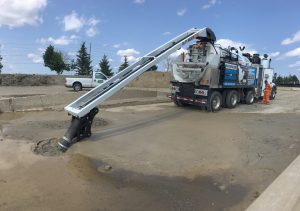
Last October Vactor launched the HXX-QX at a trade show. It offers improved weight distribution and performance.
Neither water nor air is powerful enough to blast through hard materials. When Ontario Excavac teams are faced with concrete or asphalt, their first task is to cut through these tough layers with saws before doing any soil extracting.
That said, vacuum excavators are surprisingly sturdy machines, able to function with few difficulties in cold Canadian weather.
“In wintertime, we have diesel-fired hot water heaters on the trucks that heat up the water to 45 degrees C to go through frozen ground,” states Tye.
Vactor Manufacturing claims to have built the first dedicated vacuum excavator, in 1969. The original unit was designed for utility-detecting purposes in Brooklyn, N.Y.
“However, the technology was ahead of its time and market acceptance was not gained until the late 1990’s, when Vactor introduced the HXX brand of dedicated vacuum excavators,” says Schmitt.
Last October, Vactor launched a new HXX-QX vacuum excavator at a trade show in Louisville, Ky. The pre-production model HXX-QX offers improved weight distribution, performance and payload capacity, has a new PrecisionFlow water pump system that increases water flow and a display unit that shows real-time operational data.
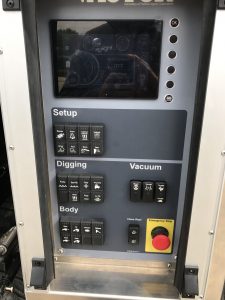
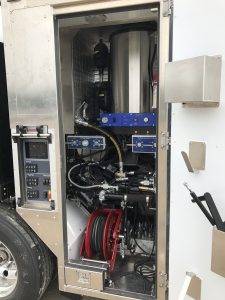 For its part, Ring-O-Matic “started with vacuum only equipment back in the early 1980s for cleaning up car wash pits. That’s how we got into the business. Then around the mid-90s, we came out with the vacuum excavator itself with water on board. And we’ve been at it ever since,” says Zylstra.
For its part, Ring-O-Matic “started with vacuum only equipment back in the early 1980s for cleaning up car wash pits. That’s how we got into the business. Then around the mid-90s, we came out with the vacuum excavator itself with water on board. And we’ve been at it ever since,” says Zylstra.
“Our trailer-mounted units are our bread and butter, our main line of equipment. We build units as small as 150-gallon debris tanks and then we go up to 3,000-gallon debris tanks that we put on truck-mounted units. Our 550VX and 850VXs are the most popular machines and the ones that we build the most of,” he adds.
To highlight the advantages of vacuum extracting, Schmitt points to a recent report by the Common Ground Alliance (CGA), an underground utility industry association based in Alexandria, Va. On August, 2017, CGA released a study that pegged excavation-related damage to buried utilities (including steam pipes, sewers, natural gas lines, cable TV and water lines) at $1.5 billion. The CGA counted 323,962 “consolidated reports” of underground infrastructure damage in Canada and the U.S. in 2016 a 12.4-per-cent increase from the previous year. The report cited backhoes, trenchers and hand tools as some of the leading culprits responsible for this damage.
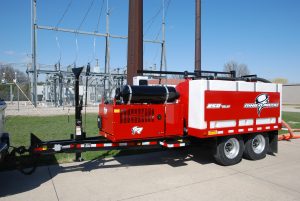
The 550VX and 850VX are the most popular machines Ring-O-Matic builds.
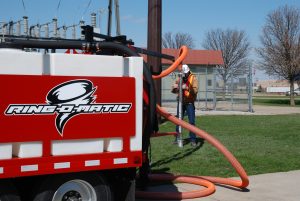 “You hear in the news now and again about gas lines being hit or 911 service going down because a utility was cut by a backhoe or some kind of other mechanical device. That’s the beauty of vacuum excavation. There’s enough high-pressure water or air to dig up the soil without potentially damaging the utility itself. So it’s actually safer than using a shovel because you eliminate any potential damage to the underground infrastructure there,” states Zylstra.
“You hear in the news now and again about gas lines being hit or 911 service going down because a utility was cut by a backhoe or some kind of other mechanical device. That’s the beauty of vacuum excavation. There’s enough high-pressure water or air to dig up the soil without potentially damaging the utility itself. So it’s actually safer than using a shovel because you eliminate any potential damage to the underground infrastructure there,” states Zylstra.
Vacuum excavating is also safer for workers. Rupturing a gas line or power cable with a shovel or backhoe can have catastrophic results for anyone working nearby. Because it’s a gentler process, vacuum excavating is far less likely to cause an explosion or electrical discharge, says Tye.
THE TECHNOLOGY
Vacuum excavating equipment has become more advanced in recent years.
“We’re seeing higher and higher CFMs (cubic feet per minute) on the machines. I think one of our first machines that came out was a 640 CFM blower. That was kind of standard at that time. We now have a 1,000 CFM machine,” states Zylstra, referring to airflow volume measurement.
In terms of broader industry trends, “We’re starting to see more truck mounted units go out as opposed to trailer mounted units. There is still a big market for trailer mounted, but there seems to be a trend going to smaller trucks dedicated to vacuum excavators as opposed to the trailer … and we’re seeing more and more machines go out with booms on them. Full hydraulic booms,” he continues.
Over the years, improvements on Vactor vacuum excavators have included enhanced boom operation, cold-weather features and control interfaces, says Schmitt. Vactor just received patent approval for a technology it calls DigRight, which “limits the maximum water pressure the operator can use, per industry best practices,” he adds.
THE OPPORTUNITY
As vacuum excavating becomes more common, new applications are being found for the process.
“You hear every now and then of some machine being used for some odd job. Normally, they’re used for potholing and mud management along horizontal directional drills but we’ve sold some into the mining industry to go into plants to help clean up slag and the kind of stuff that comes with mining operations. We’ve sold them into agricultural areas for helping clean around grain bins and livestock facilities. Anywhere you can use a shovel or need a vacuum, you could potentially put one of these machines into use,” says Zylstra.
“I know some people do get into other jobs, like roof work. Hydro vac trucks [are sometimes used] to suck gravel off rooftops. I’ve seen them do that before,” adds Tye.
Tye hopes Ontario Excavac will continue to grow, while remaining focused on doing utility work in its current base of southern Ontario. He believes the vacuum excavating industry as a whole is going to expand in the near future.
“I think it’s very fast-growing. It’s really taken off. I’ve seen a big expansion in the industry over the last three years, compared to when I started back in ’97,” he says.
What’s pushing this expansion is the fear of “damaging utilities” and the subsequent fines and lost work contractors might incur as a result.




